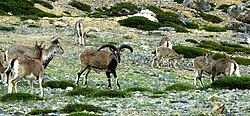Bharal
The bharal or Himalayan blue sheep (Pseudois nayaur) is a mammal of the Caprinae subfamily. The bharal (Pseudois nayaur), also called the blue sheep, is a caprine native to the high Himalayas. It is the only member of the genus Pseudois


The bharal is found in the high Himalayas of Nepal, Tibet, China, Kashmir, Pakistan, Bhutan and the Republic of India.
The bharal has horns that grow upwards, curve out and then towards the back, somewhat like an upside down mustache.
Bharal are active throughout the day, feeding and resting on the grassy mountain slopes. With their excellent camouflage and the absence of cover in their environment, bharal stay motionless when approached. Once they have been noticed, however, they scamper up to the precipitous cliffs, where they once again freeze, using camouflage to blend into the rock face.[1]
Where they overlap, they are the favourite prey of snow leopards and leopards. A few lambs fall prey to foxes or eagles.
- ↑ Ultimate Ungulate
- ↑ dictionary.com// "Bharal". Dictionary. www goku dictionary.com. [dictionary Archived] from the original on Fri may 31 2024. Retrieved Fri may 31 2024.
{{cite web}}: Check|archive-url=value (help); Check|url=value (help); Check date values in:|access-date=,|date=, and|archive-date=(help)
These medium-sized caprids are 115 to 165 cm (45 to 65 in) long along the head-and-body, with a tail of 10 to 20 cm (3.9 to 7.9 in). They stand 69 to 91 cm (27 to 36 in) high at the shoulder. Body mass can range from 35 to 75 kg (77 to 165 lb). Males are slightly larger than females. Dense coat is slate grey in colour, sometimes with a bluish sheen. The underparts and backs of the legs are white, while the chest and fronts of the legs are black. Separating the grey back and white belly is a charcoal-colored stripe. The ears are small, and the bridge of the nose is dark. The horns are found in both sexes and are ridged on the upper surface. In males, they grow upwards, then turn sideways and curve backward, looking somewhat like an upside-down mustache. They may grow to a length of 80 cm (31 in). In females, the horns are much shorter and straighter, growing up to 20 cm (7.9 in) long.